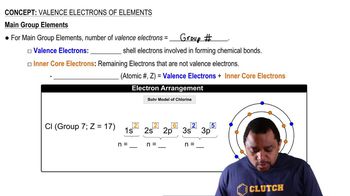Here are the essential concepts you must grasp in order to answer the question correctly.
Valence Electrons
Valence electrons are the outermost electrons of an atom and are crucial for determining how an element will react chemically. For chlorine, which is in group 17 of the periodic table, there are seven valence electrons. These electrons are involved in forming bonds with other atoms, influencing the element's reactivity and bonding behavior.
Recommended video:
Transition Metals Valence Electrons
Core Electrons
Core electrons are the electrons that are not involved in bonding and are located in the inner shells of an atom. They are typically shielded from the effects of external electric fields and do not participate in chemical reactions. In chlorine, there are 10 core electrons, which are found in the inner electron shells, providing stability to the atom.
Recommended video:
Main Group Elements Valence Electrons
Unpaired Electrons
Unpaired electrons are those that occupy an orbital alone rather than in pairs. They play a significant role in determining the magnetic properties of an atom and its ability to form bonds. In the case of chlorine, there are three unpaired electrons in its ground state configuration, which contributes to its high reactivity and tendency to form covalent bonds.
Recommended video:

 Verified step by step guidance
Verified step by step guidance


